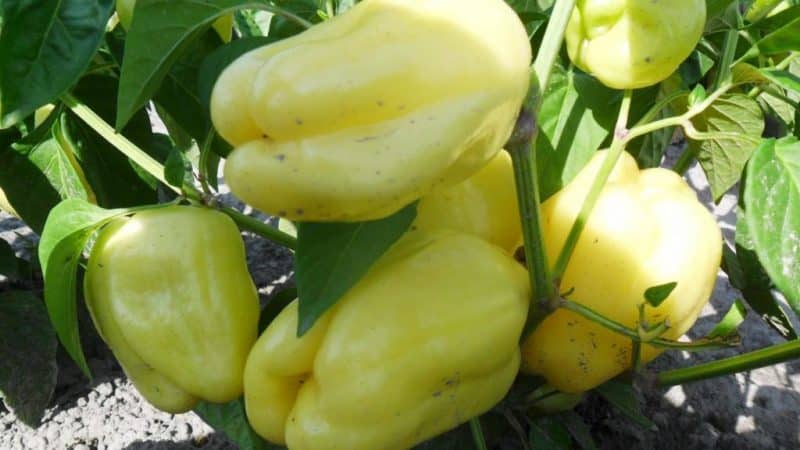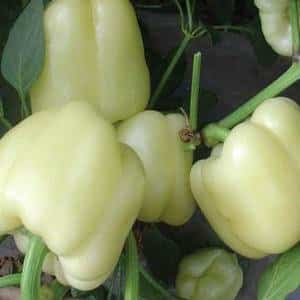Is it worth growing “White Gold” pepper: advantages and disadvantages of the variety
Every year, gardeners choose which variety of pepper to grow on their plot. The White Gold variety attracts with its high yield of sweet and juicy fruits and simple agricultural technology. Yellow peppers have a rich chemical composition: they contain phosphorus, potassium, pectin, fiber, iron, calcium, vitamins C, B, PP, A, E and essential oils.
What type of pepper is this?
The variety was included in the State Register in 2009. It got its name due to the bright color of the fruits, which stand out noticeably in the beds.
White gold - early ripening culture, despite the large size of the peppers. Technical ripeness occurs 100–110 days after the appearance of the first shoots.
Characteristics and description
The variety has smooth and neat bushes with straight stems and slightly wrinkled middle leaves. The plants reach a height of 50 cm. The trunk is durable and can withstand large fruits.
The variety is recommended for cultivation in all regions of Russia, in open and closed ground.

Distinctive features
The main feature of pepper is the bright yellow color of the fruit. Often, as they grow, they acquire pearly shades.
Compared to other varieties, White Gold ripens much earlier, and some peppers reach particularly large sizes.
Fruit characteristics and yield
The fruits are cube-shaped with a faint glossy sheen. At the technical stage of ripeness, peppers are greenish-white in color, and at the biological stage they are pearly yellow. The vegetables are dense and fleshy: their walls reach 1 cm.The average fruit weight is 200–250 g, but some reach 500 g.
Subject to proper agricultural practices, farmers harvest up to 15 kg of crop per 1 m2 in open ground or greenhouse.
The taste of peppers is sweetish with spicy notes, so the culture is great for salads.
Preparation for cultivation
Before planting the seeds, they are soaked in a nutrient solution (20 g of wood ash per 1 liter of water). The mixture is left in the growth stimulator for 24 hours, the seeds are placed in it in a fabric bag for 5 hours, then dried on a sheet of paper.
Attention! For the best effect, the seeds are disinfected in a solution of potassium permanganate before soaking.
For peppers, use fertile light soil made from leaf or turf soil, peat, sand (1:1:1) and a small amount of wood ash. The soil is disinfected by steaming a month before planting the crop (do this for several hours in a water bath, under a tightly closed lid).
Growing seedlings
Pepper seeds are planted 60–70 days before planting in the ground. Place in a deep container at a distance of 1-3 cm from each other, the grooves themselves are made no deeper than 1 cm. After planting, the container is covered with film and left in a warm place until the first shoots appear.
As soon as real leaves are formed, the seedlings are planted in separate pots. Do this carefully so as not to damage the roots:
- Compact the soil in the containers, dig a hole in the center and water it.
- Carefully remove the seedling using a spatula or spoon. If several plants are removed at the same time, the strongest and most developed ones are picked first.
- Place the plant in the hole so that the roots are free and even in the soil. In this case, the planting depth is left at the same level as before the pick.
- The soil around the seedling is carefully compacted.
- Water the plants at the roots with a small amount of water.
To avoid picking, the seeds are immediately planted in plastic flower pots (1 liter capacity), 3 pieces at a distance of 1-2 cm from each other, placing a triangle in the center of the container.
Water the seedlings with warm water as the soil dries, but without over-wetting it. Don't forget to apply fertilizer during irrigation. Calcium nitrate gives excellent results.
Important! Ready-made soil is chosen only of high quality, which will have a positive effect on the development of the crop.
An important aspect of growing is lighting. To avoid sprouts stretching, they are provided with the maximum amount of light. If there is a shortage of it, phytolamps are installed.
Attention is paid to hardening future peppers. A week before picking the seedlings, they are taken outside and left for 30 minutes, gradually increasing the time.
Planting pepper
When the seedlings have finally grown stronger, they are transplanted to a permanent place: in open ground or in a greenhouse. As a rule, this is done at the end of May, but cultivation in a greenhouse begins earlier. The culture is transferred to open ground on a cloudy day or in the evening. The soil is moistened abundantly.
For the full development of the crop, the soil on the site must be well heated (soil temperature - not lower than +10...+12 °C). There are no more than 5 bushes per 1 m2 of land, otherwise they will interfere with each other’s development. Dig holes according to the pattern: 30 by 50 cm.
At the initial stage, plants are fed with complex products. During the entire growing season, fertilizers are applied 3 times.
Attention! Fertilizing White Gold with manure will lead to active development of bushes in the leaves and a low number of ovaries.As a result, the fruits will be small in size.
Further care
Caring for the variety is not particularly difficult. It is enough to regularly water the plants, care for the soil, feed the crop and form bushes.
For irrigation, use warm, settled water (not lower than +14 °C). Drip irrigation is best when the soil does not dry out or become waterlogged. Irrigate the soil moderately, 2 times a day. Afterwards, the soil is loosened shallowly and weeds are systematically removed. The ground around the bushes is mulched with grass, sawdust or hay.
Phosphorus-potassium compounds and ash infusions are used as fertilizers. Fertilizers are applied once every 2 weeks.
When tying up bushes, supports are installed for them. Shoots are fixed to them to reduce the risk of stems breaking. Flowers and weak ovaries are cut off, and the tops of plants above 20 cm are pinched. They get rid of stepsons growing below the fork and inside the ovaries. The main bud at the branching site is removed to enhance the growth of the pepper.
Features of cultivation and possible difficulties
The most suitable regions for cultivating the variety are the regions of central Russia. Pepper grows well both in open ground and in greenhouse conditions. However, in harsh climates (in the Urals and Siberia), the crop is planted in greenhouses.
Attention! To get a rich harvest, pollinating insects are attracted. To do this, use a solution of 2 g of boric acid, 1 liter of water and 100 g of granulated sugar, which is sprayed on the bushes.
Seedlings are planted at the age of 65–70 days in order to have time to get a harvest in short summer conditions.
Typical diseases and pests
The White Gold variety is resistant not only to the tobacco mosaic virus, but also to most other diseases.However, when the shape and color of plant leaves change, spots appear on them and growth is inhibited, the crop is treated with special preparations: “Fitosporin” or Bordeaux mixture.
Frequent pests of pepper are aphids, wireworms and spider mites.. Infusions of garlic, tobacco or birch tar repel aphids and ticks, and wireworms are caught using fruit baits.
Advantages and disadvantages of the variety
White Gold Pepper has virtually no downsides. The only negative is the need to cover the plants with special material at least in early spring.
Benefits of culture:
- bushes of neat shape and small size;
- simplicity of agricultural technology;
- large tasty fruits;
- high productivity;
- versatility of use;
- long-term preservation of fruits in marketable condition;
- good transportability.
Reviews
Due to its characteristics, White Gold is considered one of the best varieties in selection. Numerous enthusiastic reviews from gardeners only confirm this fact.
Evgeniy, Bryansk: «I have been growing the White Gold variety for several years now and I want to give only one piece of advice: do not use pesticides. They will not improve the taste of vegetables, but will increase the risk of poisoning. This pepper variety is strong and can cope with diseases on its own.”
Nina, Moscow: “I love thick-walled varieties for their juiciness and texture. In my opinion, this is the best option for salads. In the summer, not a single meal is complete without White Gold pepper. I've never worked out before conservation, but the variety produces such a rich harvest that I’m starting to think about it.”
Lyudmila, Voronezh: “I have been growing White Gold in a greenhouse for a long time and am convinced that this is one of the best varieties of large yellow peppers.Many people believe that early ripening crops need special care, but I don’t think so. There is nothing complicated in the agricultural technology of vegetables, and the result surprises again and again.”
Read also:
Bright and tasty sweet pepper “Golden Miracle”.
Conclusion
Growing White Gold pepper is not difficult, since the variety is quite strong, unpretentious and not susceptible to diseases characteristic of the crop. The high yield, pleasant taste and bright yellow color of the fruits make it possible to preserve them for yourself and use them for commercial purposes.
In cooking, White gold is added to various dishes: from salads to stuffing.